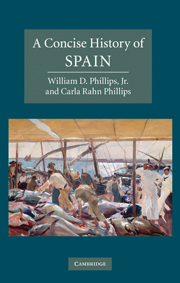Book contents
- Frontmatter
- Contents
- List of illustrations
- List of maps
- Preface
- 1 The land and its early inhabitants
- 2 Ancient legacies
- 3 Diversity in medieval Spain
- 4 The rise of Spain to international prominence
- 5 Spain as the first global empire
- 6 Toward modernity: from the Napoleonic invasion to Alfonso XIII
- 7 The struggle for the Spanish soul: Republic, civil war, and dictatorship
- 8 New Spain, new Spaniards: European, democratic, and multi-cultural
- Chronology and rulers
- Guide to further information
- Index
- Titles in the series
Preface
Published online by Cambridge University Press: 05 August 2012
- Frontmatter
- Contents
- List of illustrations
- List of maps
- Preface
- 1 The land and its early inhabitants
- 2 Ancient legacies
- 3 Diversity in medieval Spain
- 4 The rise of Spain to international prominence
- 5 Spain as the first global empire
- 6 Toward modernity: from the Napoleonic invasion to Alfonso XIII
- 7 The struggle for the Spanish soul: Republic, civil war, and dictatorship
- 8 New Spain, new Spaniards: European, democratic, and multi-cultural
- Chronology and rulers
- Guide to further information
- Index
- Titles in the series
Summary
In modern times, Spain has often been perceived as different from other countries in Europe, with a pejorative connotation to that difference. In part, at least, that perception stems from a lack of knowledge about the history of Spain. Yet, in a certain sense Spain is different from the rest of Europe, in the diversity of its population and in its close contacts with civilizations outside Europe, in historical times and into the present as well. In writing this book, we have aimed to survey the long and complex history of Spain and its regions in a form accessible to an interested readership from various backgrounds. Whether those readers are serious students of Spain or casual travelers, we hope this book will provide a useful introduction to the complex history of a fascinating country. To best accomplish this, we pay due attention to all of the periods of the Spanish past, rather than concentrating on the more recent centuries. We also try to pay due attention to the many voices contending over the Spanish past.
As we planned and produced the book, we identified a series of themes that we could follow through the millennia. Among the themes we chose were the diverse population mentioned above and the difficult and varied ecology of the Iberian Peninsula. The location of Spain between the Atlantic and the Mediterranean – and, by extension, between Europe and Africa – placed it in continual contact and potential conflict with other countries and other civilizations, from prehistoric times through the medieval centuries.
- Type
- Chapter
- Information
- A Concise History of Spain , pp. xi - xivPublisher: Cambridge University PressPrint publication year: 2010



